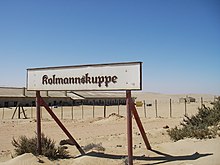Kolmannskuppe
Kolmannskuppe or Kolmanskuppe , more rarely Afrikaans also Kolmanskop , is an abandoned settlement ( ghost town ) in today's Namibia . The place is about ten kilometers east of the port city of Lüderitz in the Tsau-ǁKhaeb- (restricted area) -Nationalpark and is named after the Nama Johnny Coleman , who got stuck there in 1905 with his ox cart in a dune. He was rescued but had to leave his ox cart behind.
history
Ascent
The Lüderitz railway reached the place on its way to Aus in 1905 at the time of German South West Africa . Kolmannskuppe owes its existence to the railway workers August Stauch and Zacharias Lewala , who happened to find the first diamonds at the neighboring Grasplatz station in 1908 . The resulting boom ensured rapid growth of this settlement, initially only intended as a diamond prospecting camp, on the northern border of the diamond restricted area . The wealth of the inhabitants, based on diamonds , gave rise to a mining town in which there was a lot of luxury - and that in an environment that could hardly be thought of more desolate and hostile to life. There was no water , no rain , no earth in which even the smallest thing could have grown, no infrastructure - just sand , regular, violent sandstorms and merciless heat .
blossom
Despite the hostile environment, up to 400 people lived here and stately stone houses based on the German model were built. In addition to accommodation for the workers (separated into married couples and bachelors ), there were administrative and service buildings . The infrastructure included a power station , a hospital (with the first X-ray station in Africa or in the whole of the southern hemisphere ), an ice factory for the production of block ice for the residents' iceboxes , a corner shop , a butcher's shop, and a ballroom with a theater , Gym and large kitchen, a bowling alley and a school . There was even a salt water swimming pool and a narrow-gauge railway for the transport of goods and people within the village. The water for this and everything else that was needed for daily life had to be transported from Cape Town, around 1000 km away . The building material for the houses, their facilities, the machines and everything that was considered luxury in Europe at that time came from Germany and was mostly landed in Lüderitz.
The total diamond production from 1908 to 1913 is at 4,693,321 carats worth 151,926,000 M estimated. At least 40% of this sum, i.e. around 60 million M diamond tax, was paid to the tax authorities, a sum that could benefit the entire colony and which alone accounted for two thirds of the total income of German Southwest.
descent
At that time Kolmannskuppe was considered the richest city in Africa, which may be true given the small number of inhabitants. Nevertheless, Kolmannskuppe was only a temporary paradise. The nearby diamond fields were soon dismantled and so diamond mining shifted ever further south towards Elisabethbucht , Pomona , Charlottenthal and the Bogenfelsen . In 1930 the diamond mining near Kolmannskuppe was completely stopped, the residents gradually left the place and left it to the desert . The last person lived here until the 1960s. Many home furnishings, sports equipment in schools, etc. the like were not even taken.
Kolmannskuppe today
Over the decades, the desert recovered what man had wrested from it. The houses were falling into disrepair and the sand piled meters high in the ruins . The interior was partially destroyed or taken away. Kolmannskuppe finally became a ghost town. Only tentative museum traffic, initially based on private initiative , occasionally brought some life back. Only when Lüderitz experienced an economic boom in the 1990s, more attention was paid to Kolmannskuppe. They began to restore some buildings worth preserving, to refurnish rooms true to the original and gradually to set up an orderly museum. Today the settlement is accessible in the mornings for an admission fee and guided tours are offered; Outside these times, entry is only possible with a so-called photo permit, which is subject to a fee and must be applied for in advance .
Entry is strictly controlled and leaving the settlement area to the south is also prohibited, as diamonds are still being mined in the restricted area and smuggling is to be prevented. Popular or spectacular diamond smuggling attempts are discussed in the Kolmannskuppe Museum.
Cinematic reception
- Reinhild Dettmer-Finke: Modern Ruins - Part 1: Kolmanskop. ZDF / Arte, 2012, (5-part documentary).
literature
- Gino Noli: Desert diamonds. Kolmanskop Tour Company, Lüderitz 2007, ISBN 978-0-620-39750-6 .
- Helga Kohl, Amy Schoeman: Kolmannskuppe. Then and now. Klaus Hess Verlag, Windhoek / Göttingen 2004, ISBN 978-3-933117-17-5 .
Web links
- Official Site of Kolmanskuppe (English)
- Information about Kolmannskuppe
- Information about Kolmanskop (English)
- Kolmanskop picture collection 2012
Individual evidence
- ↑ Station sign in Kolmanskop. Retrieved June 17, 2017.
- ↑ Entrance sign to the ghost town. Retrieved June 17, 2017.
- ^ Kolmanskop - Namibia's most famous ghost town. Kolmanskop.de. Retrieved June 6, 2017.
- ↑ This German city is swallowed up by the desert. T-Online, October 30, 2014.
- ^ Goldberg: The diamond mining in German South West Africa. In: Polytechnisches Journal . 329, 1914, pp. 531-533.
- ↑ Rates | Ghost Town Tours - Kolmannskupp, Namibia. Retrieved January 14, 2020 .
- ↑ Visit Kolmanskop these days. Retrieved January 14, 2020 (German).
Coordinates: 26 ° 42 ′ S , 15 ° 14 ′ E



